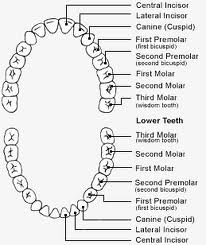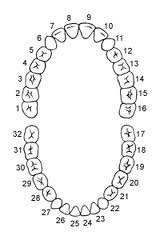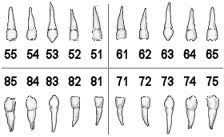Have you ever wondered what the dentist is talking bout when he says “filling on four-eight, missing one-six†etc? Here below are some of the systems used by dentists worldwide to number each tooth. First of all, you’ll need to know the types of teeth you have in your mouth.
Types of dentition
Every human being has 2 sets of dentition- the primary (milk, deciduous) dentition and the permanent (secondary) dentition. Each dentition is divided into 4 quadrants: the upper right, upper left, lower left and lower right quadrant.
- In the primary dentition, you have 2 incisors, 1 canine and 2 molars per quadrant, which means you have 20 milk teeth altogether.  These teeth are generally smaller in size compared to the permanent teeth, and are whiter in color, hence the term “milk toothâ€.
- In the permanent dentition, you have 2 incisors, 1 canine, 2 premolars, and 3 molars per quadrant, which comes to a total of 32 permanent teeth altogether.
Types of teeth
-
Incisors
There are 2 incisors per quadrant, the central incisor, which is situated nearer the midline and the lateral incisor, which is the 2nd tooth from the midline. They are rectangular in shape, and are used to cut into food, like a knife.
-
Canine (cuspid)
Known popularly as the “vampire toothâ€, a canine has a sharp torpedo-like tip. This tooth has the longest root and is usually the last tooth in the mouth to be extracted. Canines serve an important role in occlusion, or how your teeth come together as you close.
-
Premolars (bicuspid)
These teeth are present only in the permanent dentition, and there are 2 premolars per quadrant, the 1st premolar and the 2nd premolar. These teeth take the place of the primary 1st and 2nd molars after they are shed off.
-
Molars
There are 3molars in each quadrant, the 1st, 2nd and 3rd molar. The 3rd molar is also known as your wisdom tooth, and may not be present in some individuals. Molars are used to crush food into finer particles so that you can swallow the food.
To understand the tooth numbering system, you’ll have to visualize the teeth from a dentist’s point of view, ie viewing a patient’s teeth from the front. So the “upper right tooth†is actually the upper tooth on your left side.
Tooth-numbering systems:
1. Universal system
Permanent dentition:
The upper teeth are numbered from 1 to 16 starting with the right 3rd molar to the left 3rd molar.
The lower teeth numbered 17-32 are the lower left 3rd molar to the right 3rd molar.
So, for example, a patient’s “upper right 1st molar†is numbered as “3â€, whereas the patient’s “lower left central incisor is numbered as “24â€
Primary dentition:
To differentiate the primary dentition, uppercase letters are used instead of numbers as below:
By putting the tooth number into a diagram as seen above, the vertical line in the middle separates the right from the left, and the horizontal line between the 2 rows of numbers separates the upper from the lower teeth. Hence, starting from the your upper left corner and going clockwise, the 4 quadrants indicated are the patient’s “ upper right, upper left, lower left, and lower right†quadrants.
2. Palmer-Zygmondy system
 Permanent dentition:
For every quadrant, the teeth are numbered 1 to 8 starting with the central incisor right up to the 3rd molar.
The tooth is denoted by the number 1-8, while the quadrant it belongs to is in the form of an “L-shaped” or “inverted L-shaped” symbol, depending on the quadrant. For example, the patient’s upper right 1st premolar is denoted as :
Primary dentition:
Again, for primary tooth, the uppercase letters A to E are used to denote a different tooth in each quadrant
Eg: the patient’s primary lower right central incisor is denoted as
3. The 2-digit system proposed by Federation Dentaire Internationale(FDI)
This system for both primary and permanent dentitions has been adopted by the World Health Organization (WHO) and accepted by other organizations such as the International Association for Dental Research (IADR).
Permanent dentition:
The 1st number in the 2-digit system represents the quadrant the tooth is in, ie, 1, 2, 3 and 4 indicates upper right, upper left, lower left and lower right quadrant respectively.
The 2nd number indicates what tooth it is, as in the Universal system. So, the number 1=central incisor, 2=lateral incisor, 3=canine…8=3rd molar.
In this numbering system, the 2 digits are read number by number. For example, “41â€, which refers to the lower right central incisor, is read “four-oneâ€, and NOT “forty-oneâ€.
Primary dentition:
Uppercase letters are not used in this system. Instead, the numbers 5, 6, 7 and 8 are assigned to each quadrant instead of 1, 2, 3, and 4.





